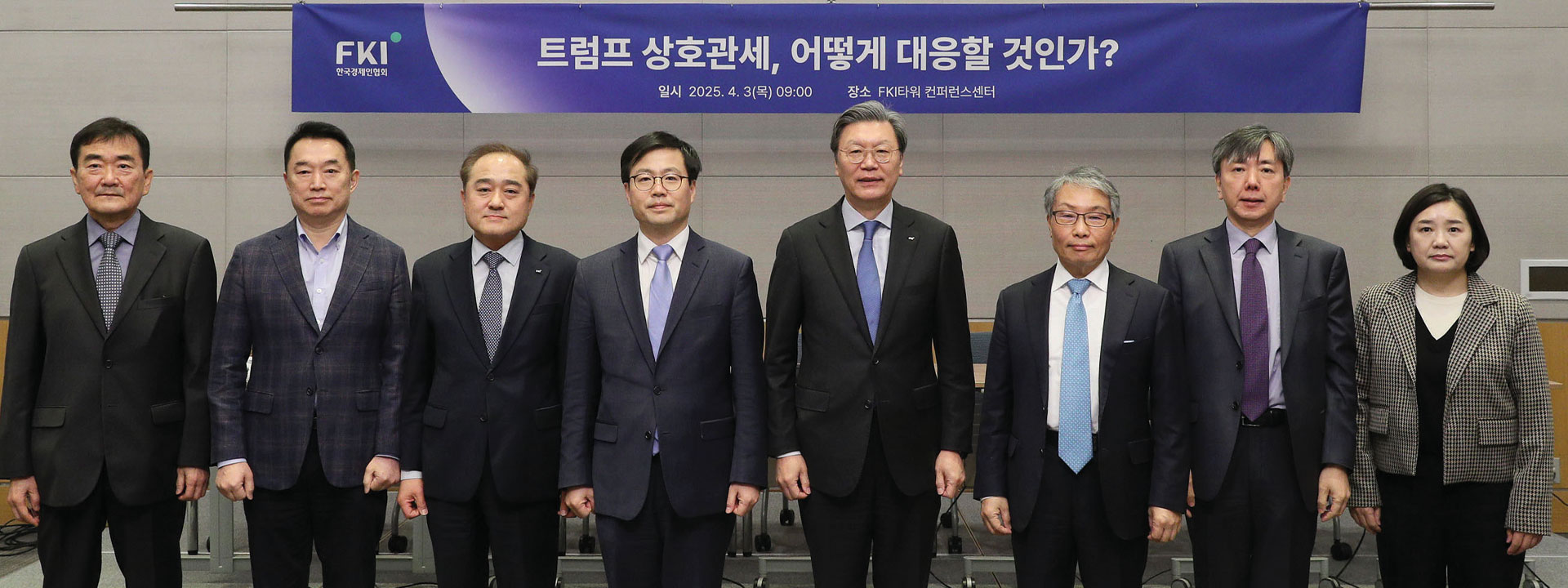Trump Administration 2.0: The First 100 Days
Trump’s Reciprocal Tariffs
Must be addressed by
‘Team Korea,’ a systematic
public-private cooperation unit
On April 2 (EST)—in the early hours of April 3 KST—U.S. President Trump announced sweeping, global reciprocal tariffs. Reciprocal tariffs of 25% were imposed on Korea, while China, Japan, and E.U. faced rates of 34%, 24%, and 20%, respectively. On top of this, baseline tariffs of 10% were imposed on all countries. In short, the stage is set for a global tariff war and there is concern that the spread of protectionism may have a domino effect. To address these dramatic global trade shifts, the FKI held an emergency seminar on April 3 under the theme of “Addressing the Trump Reciprocal Tariffs,” to generate strategic response measures for Korean businesses.
Photographer Dong-yeol Kim
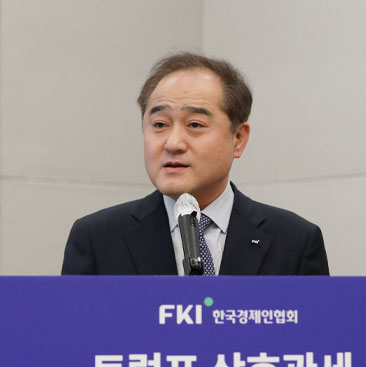
Chul Chung
- CRO of FKI and president of KERI (Chair)
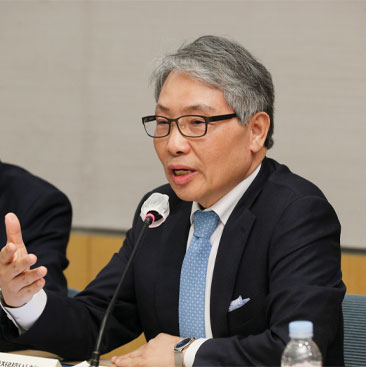
Byung-il Choi
- Director of Trade Strategy
and Innovation Hub at Bae, Kim & Lee LLC
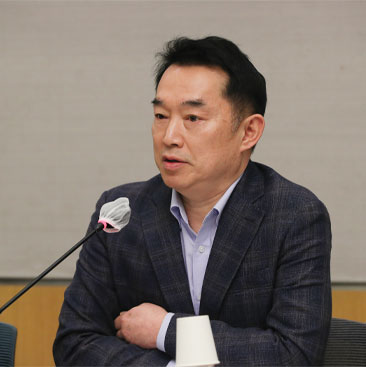
Yoon Heo
- professor at Sogang
University and visiting
research fellow at KERI
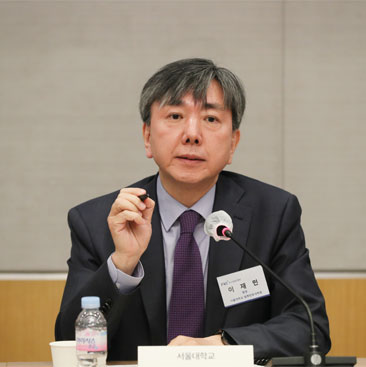
Jae-min Lee
- dean of Seou
National University School of Law
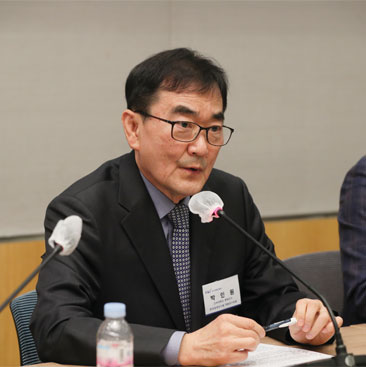
Inn-won Park
- professor emeritus at Korea University and
visiting research fellow at KERI
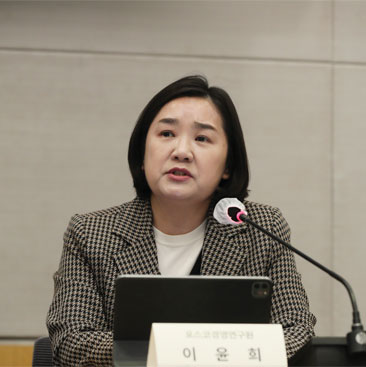
Yoon-hee Lee
- managing director at POSCO
Research Institute (POSRI)
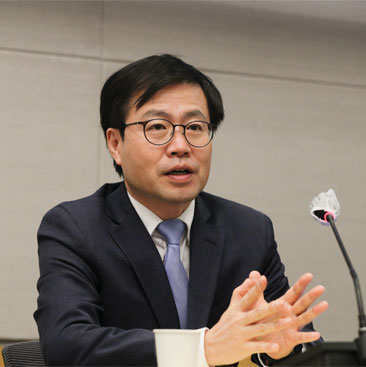
Han-koo Yeo
- senior fellow at PIIE (Former
Minister for Trade of Korea)
Han-koo Yeo senior fellow at the Peterson Institute for International Economics, PIIE (Former Minister for Trade of Korea)
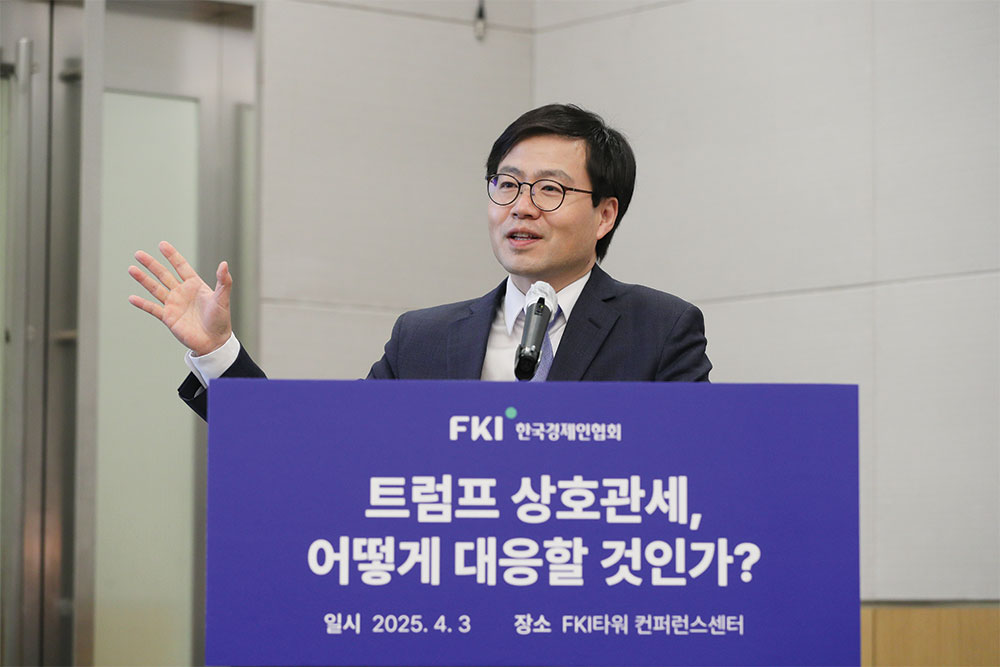
President Trump’s ‘Liberation Day’ Declaration
President Trump declared April 2 as ‘Liberation Day,’ marking the announcement of a fundamental restructuring of U.S. economic and trade policy. It is akin to an economic version of the Declaration of Independence. The move, however, can be characterized as a de-facto backward step for free trade and multilateralism.
An opening phase for negotiations; tariffs must be addressed strategically and dispassionately
The most notable tariffs can be categorized as follows: Reciprocal tariffs, baseline tariffs, and tariffs on key industries and specific nations. The tariffs announced on April 2 (EST), included a 25% reciprocal tariff on Korea. I believe this is excessive as it lacks consideration for Korea’s 13-year FTA partnership with the U.S. as well as Korea being the largest source of U.S.-bound FDI for the past few years. This is especially surprising when we consider that the reciprocal tariffs placed on Korea are greater than those imposed on the E.U., Japan, Australia, and Singapore (20%, 24%, 10%, and 10%, respectively).
It is difficult to accept such measures as wholly reasonable. However, these reciprocal tariffs mark an opening phase for negotiations; they are not the end point. We must observe the situation dispassionately and prepare for negotiations in a calm and methodical manner. Also, we should take this opportunity to review how we can bolster general competitiveness and productivity in the Korean economy. The resulting improvements should then be reflected in the negotiation strategies addressing non-tariff barriers.
Another point of note is that Washington’s policy decisions are being implemented in a top-down fashion; President Trump is the decision-maker, and his secretaries and working-level officials serve as his messengers. I believe that when Korea’s political situation is normalized, we can form a stronger support system for negotiations and reach more reasonable terms.
Strategically build a diverse negotiation package
It is evident that the Trump administration is pushing strongly for structural shifts. However, we must consider Trump’s business background and ‘take him seriously, but not literally.’ In such an uncertain state, our businesses should avoid wasting energy on short-term noise and instead focus on building a consistent, long-term strategy. Public-private cooperation is critical. It is not realistic to expect individual businesses to shoulder billions of dollars of investments amid an atmosphere of ongoing confusion and aggressive tariffs. Therefore, it is necessary to build cohesive public-private cooperation that bolsters Korea’s bargaining position, after which a high-impact proposal can be presented to the U.S.
There is opportunity to be found in U.S.-China decoupling. As trade with China grows more challenging for global and U.S. businesses, there is a growing interest in partnering with Korean companies. Asian economies in similar straits with Korea, such as Japan and other U.S. allies, as well as Taiwan, may coordinate negotiations with the U.S. If necessary, a cooperative framework for risk distribution may be formed.
Government and business responses to policy uncertainties in the Trump era should be guided by long-term objectives. We must remain dispassionately committed to strategic judgments, joint measures, and international cooperation.
Chul Chung CRO of FKI and President of the Korea Economic Research Institute, KERI
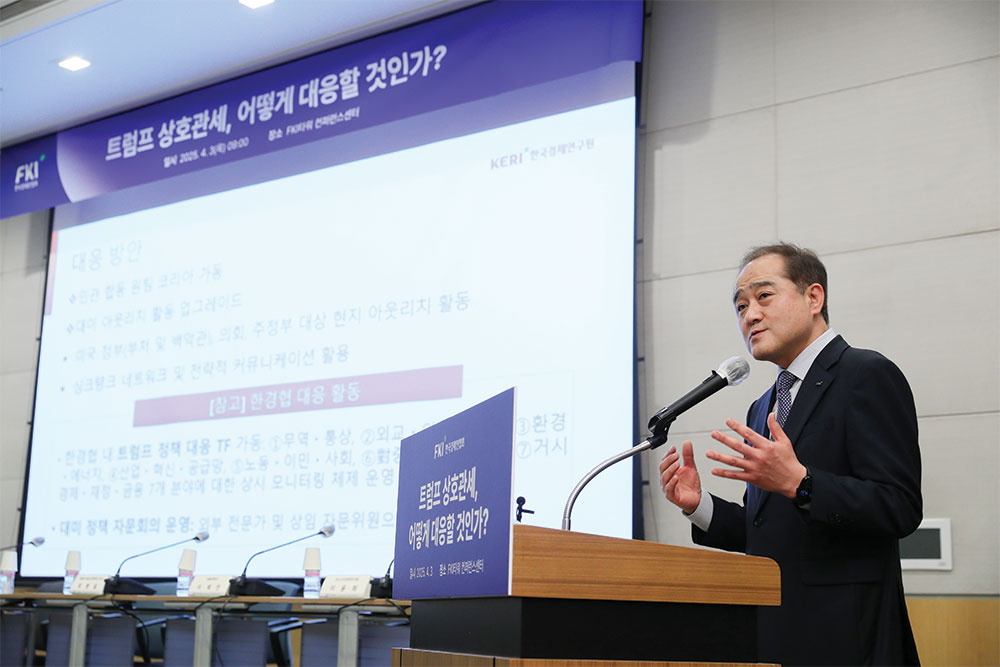
Trump holds the initiative in shifting the international trade order
Trump holds the initiative, meaning that the U.S. president will not be stopped and his decisions take priority over all others. The tone of Trump’s tariff policy announcement was characterized by a mood of high morale and President Trump seemed certain that his tariff measures would truly benefit America.
Reciprocal tariffs seem to be merely the opening act, and the stage is now set for a grand transition in the international trade order. The WTO already seems to be ineffective, and FTAs have had little effect on the recently announced reciprocal tariffs. The Korean government hoped to leverage the KORUS FTA as a stepping stone for negotiations, but it seems unlikely that the U.S. will be swayed by that.
During his announcement of reciprocal tariffs, President Trump remarked that Korean tariffs on U.S. exports were four times higher than those imposed by the U.S. on Korean exports. The MFN tariff rates between the two countries in 2023 was 3.3% for the U.S. and 13.4% for Korea, and it seems as though Trump’s “Four times higher tariffs” remark was based on a simple comparison between MFN tariff rates. MFN tariff rates have no bearing on actual tariff rates, and reciprocal tariffs imposed on such a basis may disrupt domestic manufacturing supply chains in the U.S. Meanwhile, exchange rate issues are being floated at a time of growing concerns over inflation and a possible economic downturn. At the same time, critics within the U.S. are voicing louder concerns as the calculation bases for the tariffs remains undisclosed.
Outreach toward the U.S. requires a refined and multi-dimensional strategy
The U.S. is utilizing tariffs as a multipurpose tool: For negotiations, pressuring, and macroeconomic purposes. The U.S. seeks to leverage tariffs in negotiations to gain the high ground; pressure economies running a trade surplus against the U.S.; and fulfil macroeconomic objectives, including generating tariff revenues.
Korea may be able to identify opportunities if we align our negotiation strategies around the policy objectives of the Trump administration. To this end, the latest tariffs should be perceived as a starting point for negotiations. We need to establish a joint response team, ‘Team Korea,’ composed of both government and business. It is particularly important to strengthen our outreach to the U.S., and refine our strategy in that regard. In addition to reaching out to the U.S. federal government and legislature, it is crucial to conduct parallel outreach toward state governments and legislatures as well as the local community. Also, we need to build a storytelling framework to help reinforce Korea’s strategic value to American society. By cooperating with U.S. think tanks and opinion leaders, offering hard statistics and a persuasive narrative, we can better extend our message to Americans through American voices.
Moreover, we note that that it was the U.S. that brought forth the shipbuilding industrial cooperation initiative. Therefore, underscoring the special relations between Korea and the U.S. or the ROK-U.S. security alliance may lead to positive results. Such prospects do exist, as the recent executive order notes that while the U.S. will raise tariff rates on retaliating economies, they could be willing to lower them for aligned economies. In sum, the joint Korean public-private response needs to prioritize medium- to long-term strategies over short-term responses and instead of linear approaches, we need to subscribe to a multi-dimensional outreach strategy toward the U.S. to maximize our persuasive potential.
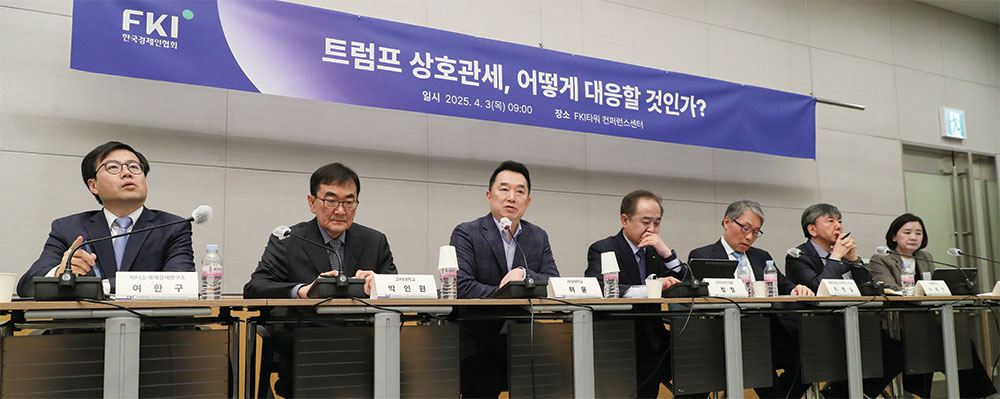
The recent announcement of tariffs by President Trump marked the end of an era of free trade. However, they also represent a starting point for negotiations, rather than an end. Therefore, a focal point for cohesive and systematic public-private cooperation needs to be established. Chul Chung, CRO of FKI and president of KERI, as well as experts from various fields, discusses the recently announced tariffs.
Byung-il Choi The recent announcement of tariffs was received with “shock and awe” in Korea, as 80% of our country’s GDP relies on trade and manufacturing. Trump prefers to start negotiations by announcing unexpectedly high figures and this approach is distinct from other country-to-country negotiations.
We need to understand Trump’s view of Korea and defy those expectations. For example, we need to position Korea as a close partner of the U.S., and convey that Korean advanced industries are necessary to counterbalance China. We need a realistic approach to demonstrate that Korea’s partnership is essential to U.S. economic strategy. We could opt to take a hardline approach like the E.U. or Canada, shoring up Korean domestic political support, but instead we should build a negotiation strategy that can address fundamental issues. Also, given that President Trump rarely invokes the word “alliance,” Korea must demonstrate its concrete strategic value to the U.S without relying on that framework.
Yoon Heo Trump’s recent tariffs may align with political calculations, but it will be challenging to maintain them economically. Tariffs exacerbate inflation and therefore act like taxes; they cannot be a means for reducing taxes. The same principle applies to exchange rates. It would be difficult for the Fed to cut rates when there is unpredictable and recurring concern over rising prices. With rising uncertainties in the U.S. economy, domestic and foreign investment and manufacturing production in America are all trending downward. This is why the Trump 2.0 trade policy is unlikely to be successful.
I believe that the U.S.’ reciprocal tariffs are not a product of transient policy, but an extended structural shift in line with deglobalization—they are a byproduct of economic nationalism and political calculation. The announced tariff rates are quite high, but the U.S. manufacturing base is already fundamentally weak. Among highly competitive items among exporters, I think Korean businesses still possess a degree of advantage.
If other countries retaliate against U.S. tariffs and the U.S. responds tit-for-tat, the global economy will receive a significant blow. However, I do not expect Trump to go down the vicious cycle route, given the economic situation in the U.S. We need to capitalize on every opportunity for negotiations and be guided by long-term objectives.
Jae-min Lee Upon hearing the tariff announcement, three things came to my mind. First, I think this is the biggest shift since the inception of the international trade system in 1947. Second, although the tariff rates pose a big challenge, we have avoided the worst-case scenario. So, our next moves will be critical. Finally, in the coming 2 to 3 months and perhaps 1 to 2 years, we will need to conduct organized negotiations with the U.S., taking advantage of Korea’s history of effective public-private cooperation. Going forward, negotiations with the U.S. will require more strategic judgment and planning as well as greater cohesiveness and precision than ever. The worst-case scenario that we must avoid is making concessions to the U.S. but failing to earn their trust.
Notably, the executive order referenced phrases like “national security,” “economic security, and “state of emergency” over twenty times. We must take this into account and during negotiations, convey Korea’s strengths and differentiating factors. We must persuade the U.S. that Korea is an especially ‘special partner,’ given that we can aid with national security crises facing the U.S., especially through Korea’s manufacturing capabilities in shipbuilding, defense, nuclear power plants, LNG, semiconductors, and steel. It may be difficult to have the 25% tariffs rescinded altogether, but the chance of having them lowered is likely high. We can begin to overcome the current economic crisis by taking advantage of lowered tariff rates as per the KORUS FTA and by maintaining our comparative advantage.
Inn-won Park The irony is that the dismantlement of the U.S.-built global order is being triggered by U.S.-imposed tariffs. Korea’s high external dependence requires that we prepare for global market contractions due to this U.S.-led tariff war. We cannot control global market demand, but we need to develop realistic measures to push back against global market contractions.
Just as we implemented the China+1 strategy during the U.S.-China conflict, there is a need to seriously consider a U.S.+1 strategy. Joining the CPTPP would also be helpful, and we must deploy Korea’s advantages to the fullest. The APEC Summit, hosted by Korea this year, can serve as an occasion for discussing the step-by-step implementation of Asia-Pacific free trade. Given that six out of the ten largest destinations for U.S. exports are APEC members, their expression of commitment to free trade can contribute to resolving global trade uncertainties, and Korea may be able to claim some measure of influence.
Korea is recognized as a top beneficiary of the WTO system, but we are vulnerable to global disruptions due to our focus on exports and particular industrial trade items. I believe that this should serve as a catalyst for trade diversification.
Finally, the core issue in trade lies in exchange rates. There is a need to develop stronger government policy to control volatile exchange rates.
Yoon-hee Lee The Korean economy and exporters have grown and benefitted under the free trade order. With the emergence of Trump and an ongoing realignment of supply chains, the biggest challenge for us is acclimatizing to and overcoming issues related to the new global order.
Multilateralism is on the retreat and the U.S. and E.U. are internalizing supply chains to lower their reliance on China. If Korea fails to be included in critical supply chains, the foundation of our current growth model will be called into question. The level of uncertainty remains too high for investment decisions to be made with confidence. Regarding reciprocal tariffs, uncertainties include the possibility of tariff adjustments based on negotiations, as well as differentiated tariff imposition standards applicable to competing countries such as China and Japan. From the perspective of businesses, it is inevitable that exports to the U.S. will shrink in the short-term. Key industries, including automobiles, semiconductors, and batteries are under enormous pressure over this. Strategies to expand investments in North America and diversify supply chains are therefore urgently needed. Also, despite the U.S. manufacturing landscape being unstable, Korean businesses need to leverage relationships with American partners to bolster local outreach.
A request to the Korean government: The tariff issue is being portrayed in an unduly pessimistic light, which businesses are finding it challenging to overcome. This is becoming a large burden on trade activities. Major portions of tariff negotiations will be handled through government-to-government channels, so the authorities should play a bigger role in helping address the excessively negative light being cast over Korea.
Han-koo Yeo President Trump’s interest in carrying forward a joint Korea-Japan LNG project calls for closer Korea-Japan economic cooperation. The LNG project has been under discussion for many years, but due to low economic feasibility little progress was made. Japan and Taiwan’s proactive engagement seem to be an unavoidable choice that prioritizes a response to strategic shifts over economic feasibility. In the current situation, a way forward may be to form a consortium to distribute risk among Korea, Japan, and a third country. With multilateral trade on shaky footing, Korea also needs to seriously consider joining the CPTPP, as our membership may foster a Korea-Japan FTA. Meanwhile, Trump 2.0 may be favorable toward a more rapid arrangement than formal FTA talks, instead, focusing only on necessary provisions. So, we should assume that the KORUS FTA will continue to stand, whilst also being open to various forms of negotiations. On non-tariff barriers, Korea’s circumstances are better than non-FTA partners such as Japan. However, non-tariff barriers still pose a considerable challenge in our competition with U.S. businesses. Non-tariff barriers are also a politically delicate issue, so strategic judgment and negotiations will be necessary.
Chul Chung Having spent the past two months in Washington, D.C. to assess the landscape in the U.S., it was anxiety-inducing to witness a daily flood of new issues and announcements. Overcoming these difficulties will require public-private alignment and joint measures. These efforts will include networking with local partners in Washington, D.C. who can directly influence President Trump’s decision-making, and developing a storytelling framework that can effectively convey Korea’s perspective. This mix of medium- to long-term efforts, I believe, may contribute to solidifying Korea’s long-term growth.
